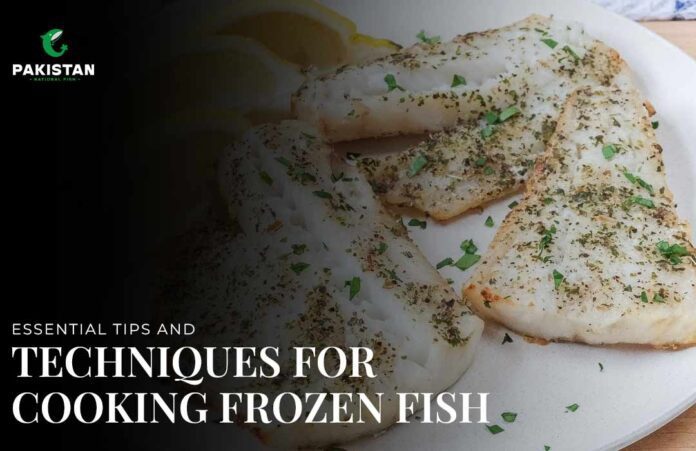Most of the fish we consume, including fresh fish, has been frozen at some point. The truth is that the fish we eat was either frozen at sea or at some point along the supply chain, before being thawed and supplied at the fish counter. Of course, if you live close to the sea and you get your fish first thing in the morning, then perhaps you are the exception. Thus, it makes sense why frozen fish and seafood have grown in popularity among consumers in recent times.
Keeping in view the increasing demand for frozen fish, we have compiled the essential tips and techniques for cooking frozen fish in this blog.
What is Frozen Fish?
Fish that has been frozen and preserved is known as frozen fish. Because it can be kept for long periods of time and doesn’t need to be cooked or otherwise prepared, it is a preferred method of preservation.
Whole fish, fillets, and steaks are just a few of the different ways that frozen fish can be found. It may be used in a range of fish recipes and is a cost-effective and practical choice for numerous individuals. It is a good provider of other nutrients, including protein.
Benefits of Eating Frozen Fish

1. Delicious Taste
Some people claim that frozen fish has a distinct, unfavourable taste and that the natural flavours have been diminished. With the freezing technology of today, though, this is rarely the case. More food is being frozen than ever before, frequently at its freshest.
Nutrients and flavour in fish are therefore retained. There are several techniques to make frozen fish taste fresh, even if you think frozen fish tastes different.
2. Safer to Eat
Not all fish that is labelled as “fresh” is indeed so fresh. Bacteria have an extended period of time to proliferate on dead fish. It can make you sick, particularly if it’s not made correctly.
Fish that has been frozen immediately stops bacterial growth and eliminates any parasites that the fish may have been harbouring. When customers enjoy a baked or poached fish fillet from a fish restaurant or cafeteria, this keeps them safe.
3. More Affordable
The low cost of frozen fish is one of its main advantages. Whether you’re purchasing a fresh fillet for a special dinner or in bulk for a restaurant, fresh fish can get pricey. However, because frozen fish have a longer shelf life, it is usually less expensive.
A wide variety of tasty and reasonably priced frozen fish items are available in grocery stores and wholesale retailers, making them a perfect complement to any meal.
4. More Sustainable
Fish loses its freshness quickly. It will break down and become inedible eventually, just like most things. This implies that fresh fish goes to waste if it isn’t sold and consumed right away. Given that over 3 billion people worldwide consume fish, this waste is harmful to both the environment and human health.
For this reason, it’s critical to fish sustainably, and one aspect of that is freezing seafood. Fish may be kept longer by freezing it, which prevents food waste and the need to constantly restock the supply.
Techniques for Cooking Frozen Fish
1. Grilling
Works best for whole fish with skin on, but requires intense heat quickly. To improve the flavour, stuff the fish’s cavity with aromatics like citrus, allium, and herbs. To prevent the fish from sticking to the grate, brush it with oil and sprinkle fresh herbs on top for an added burst of flavour. Use entire or skin-on fillets of white-fleshed, fatty fish.
2. Pan-searing
Perfect for a fillet with or without skin. If the skin is on, place the fillet skin side down in a pan and score it with a few diagonal slashes to keep it from curling while cooking. Use firm, flaky, and fatty fish. (If using fish that is lean, leave the skin on.)
3. Poaching
To ensure that fish is cooked through on both sides, thoroughly submerge fillets in boiling water or stock. A common accompaniment to cold poached fish is hollandaise sauce and fresh potatoes. Utilise flaky, lean fish. Don’t use too oily fish; instead, use extremely fresh fish.
4. Roasting
Bake whole fish at 375 F in the oven, or 400 F for thick fillets. Furthermore, adding aromatics like fresh thyme sprigs and rosemary would greatly diversify the flavour. Try slow-roasting fish at 275 degrees for a more delicate texture (twice the cooking time). Use whole or large fillets of fatty fish.
5. Broiling
A convenient way to achieve grilled flavour without using a grill is to broil. This method works well for small, entire fish such as striped bass or porgy, as well as fillets of any size. Bake frozen or thawed fillets at 400 degrees Fahrenheit (375 degrees Fahrenheit for the entire fish). Use fish fillets that are thick and fatty.
Conclusion
Frozen fish offers a convenient, cost-effective, and sustainable option for various culinary preparations. With proper handling and cooking techniques, frozen fish can be as flavorful and nutritious as fresh fish. Essential methods include grilling for whole fish with skin, pan-searing for fillets with or without skin, poaching for lean, flaky varieties, roasting for a rich texture, and broiling for a quick, grilled flavour. By following these techniques, you can ensure that your frozen fish dishes are delicious and retain their quality, making them a valuable addition to any meal.


